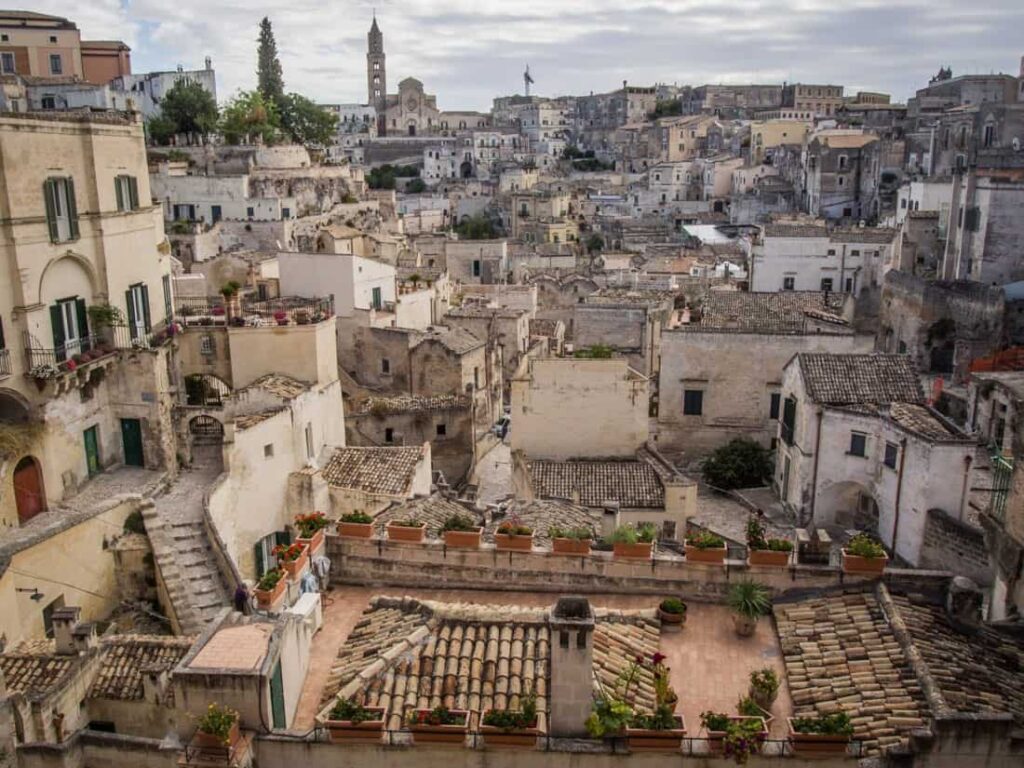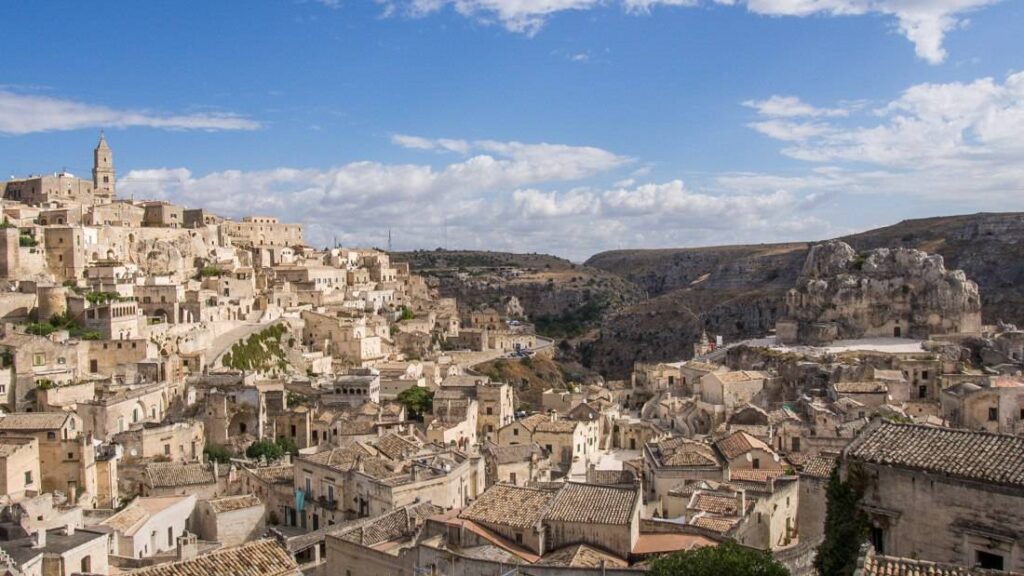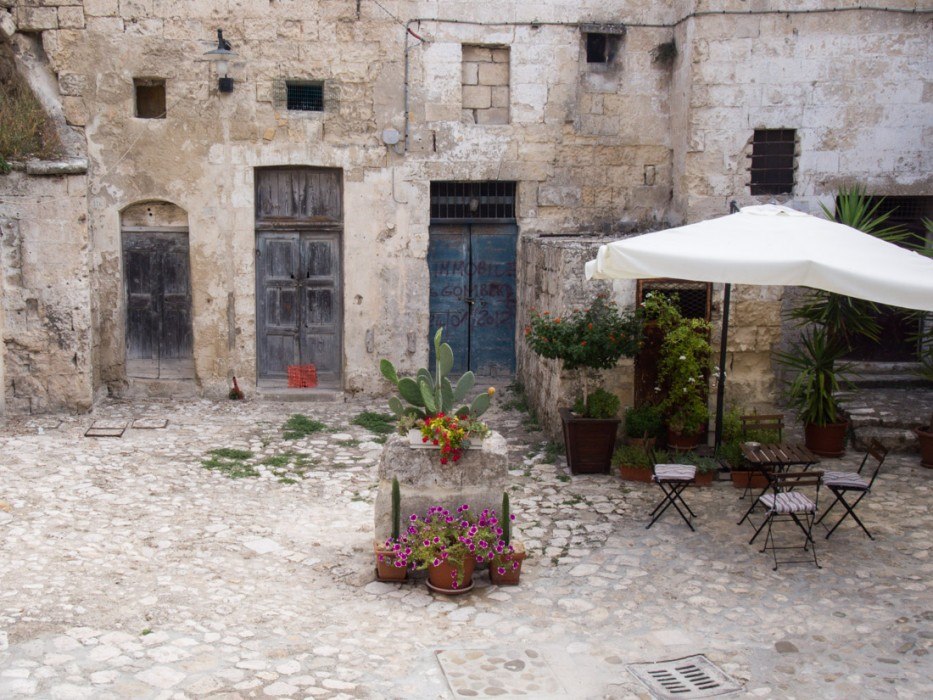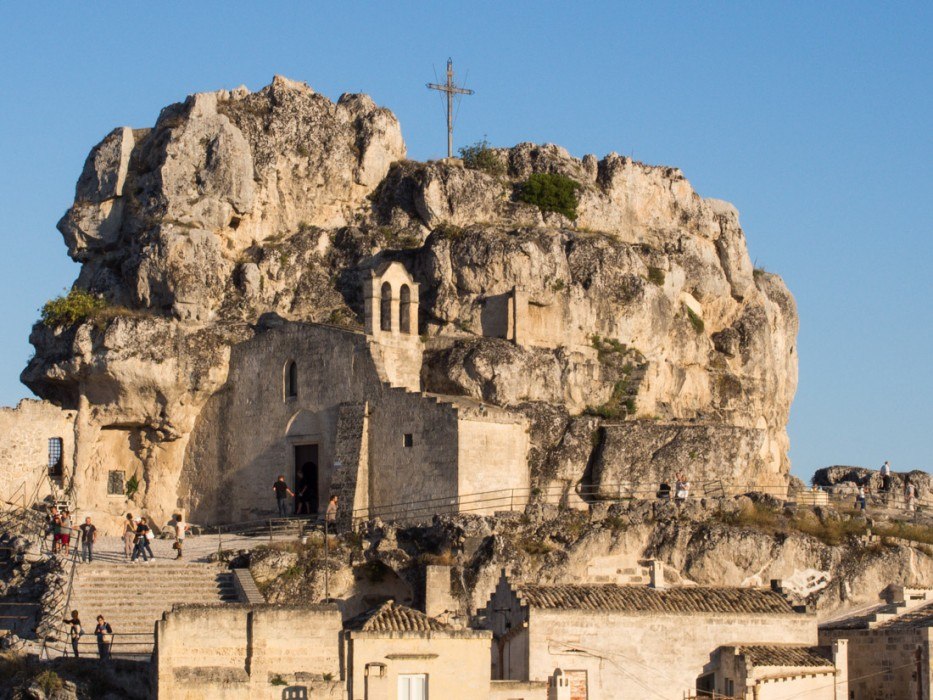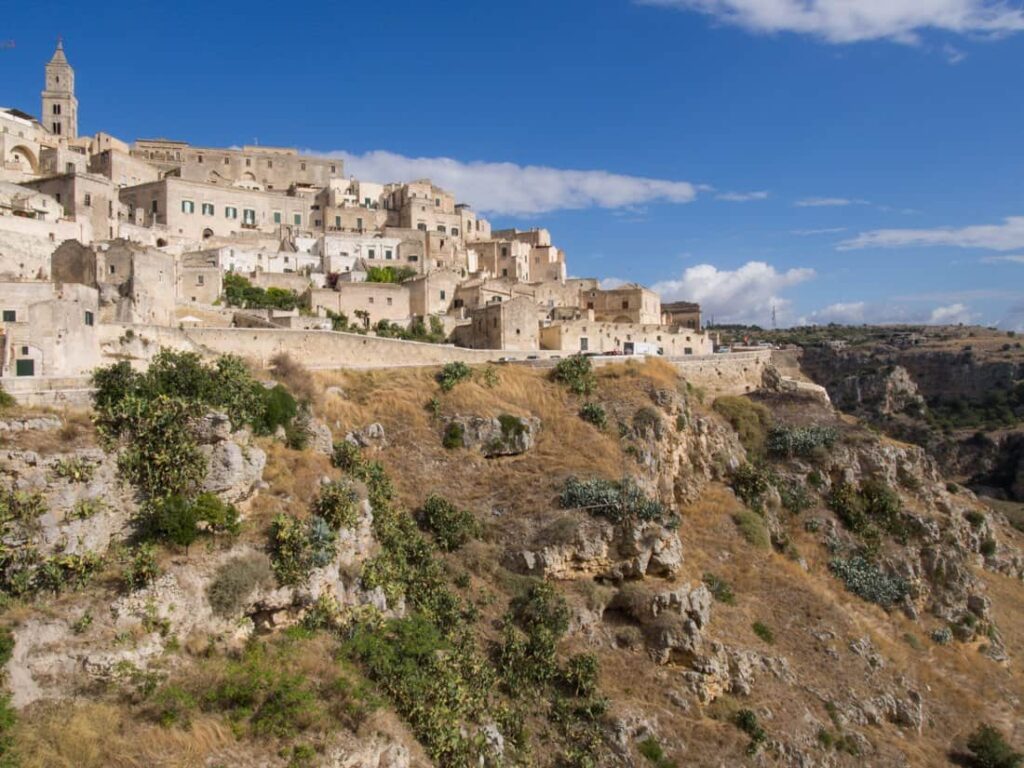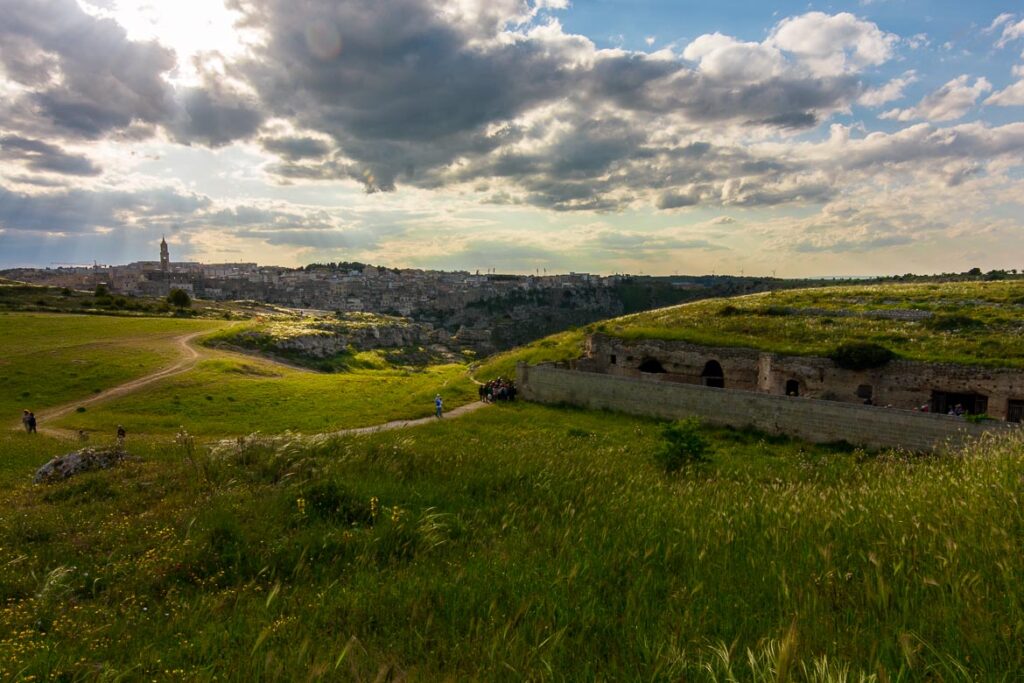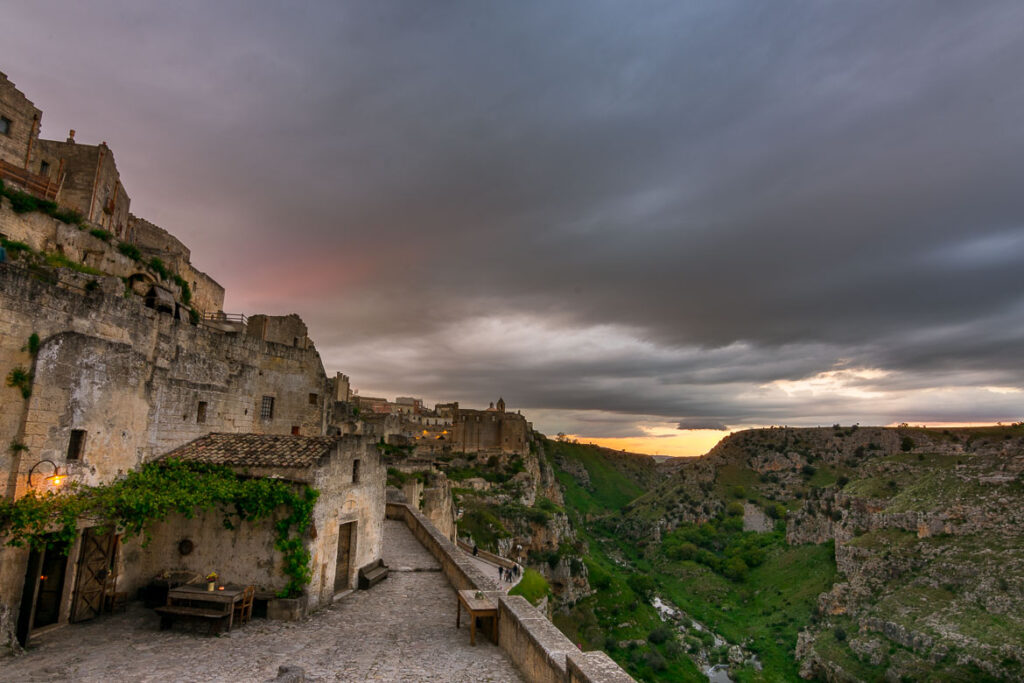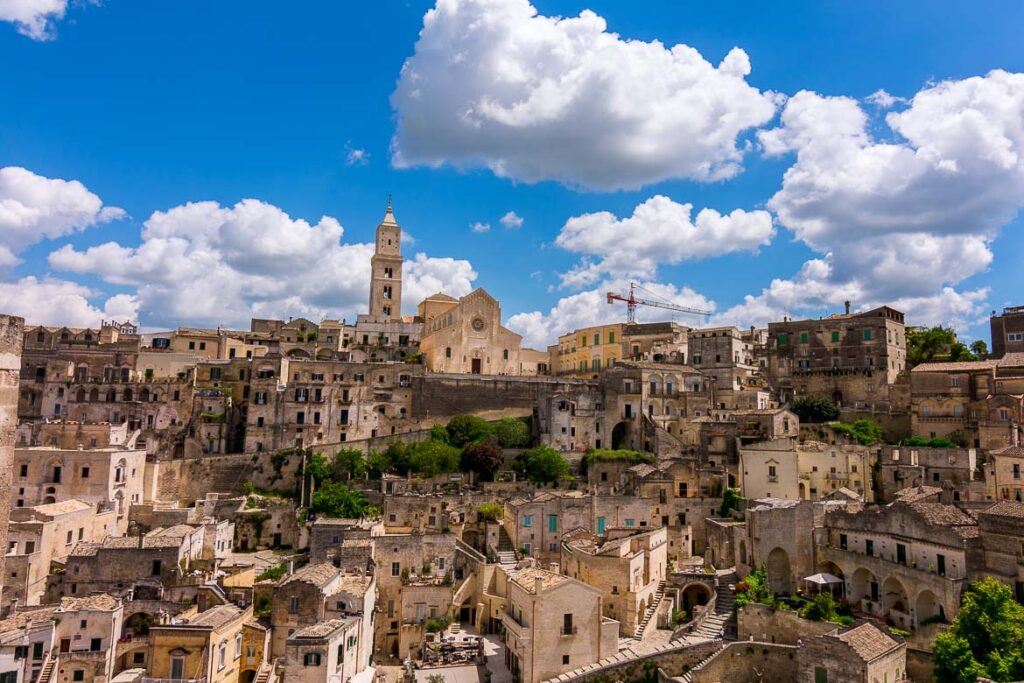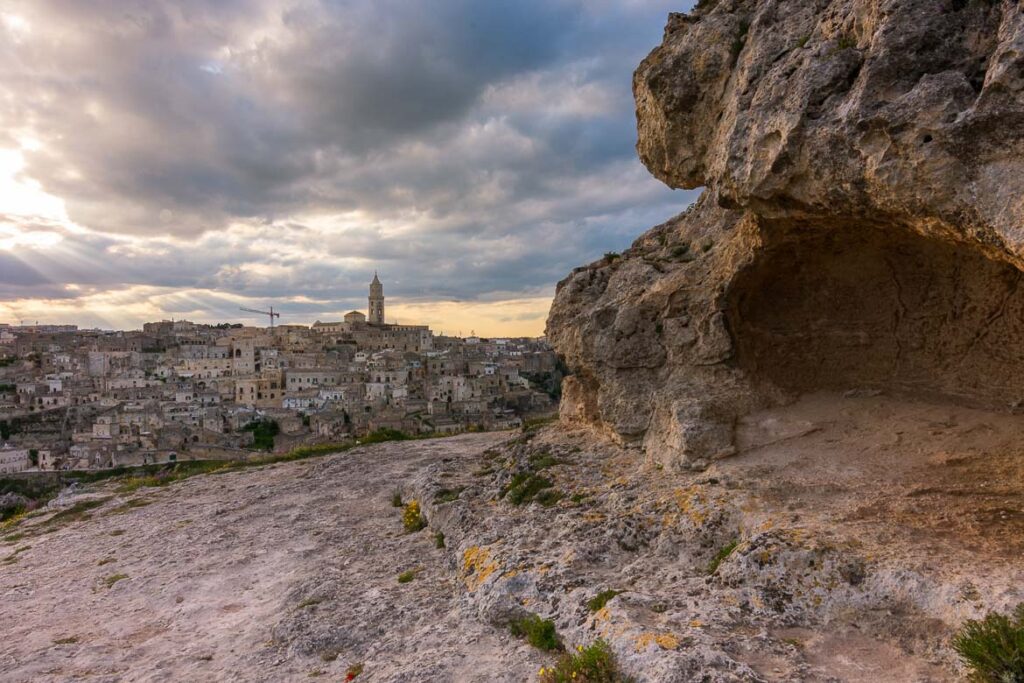In Matera you’ll spend a lot of time in caves. You’ll sleep in a cave, eat in a cave, drink an aperitivo in a cave, and even view modern sculpture in a cave. The ancient neighbourhoods, known as sassi, are a series of grottoes carved out of limestone, teetering on the edge of a ravine.
Matera is a city in the region of Basilicata, in Southern Italy. Matera is located in a remote corner of southern Italy in the small region Basilicata. It’s not the easiest place to reach which is why it has managed to remain relatively unknown, especially to foreign tourists, although since it became a UNESCO World Heritage Site in 1993 visitor numbers are slowly growing and many of the caves have been transformed into stylish hotels and restaurants.
HIGLIGHTS
As the capital of the province of Matera, its original settlement lies in two canyons carved by the Gravina River. This area, the Sassi di Matera, is a complex of cave dwellings carved into the ancient river canyon. Over the course of its history, Matera has been occupied by Greeks, Romans, Longobards, Byzantines, Saracens, Swabians, Angevins, Aragonese, and Bourbons.
By the late 1800s, Matera’s cave dwellings became noted for intractable poverty, poor sanitation, meager working conditions, and rampant disease. Evacuated in 1952, the population was relocated to modern housing, and the Sassi (Italian for “stones”) lay abandoned until the 1980s. Renewed vision and investment led to the cave dwellings becoming a noted historic tourism destination, with hotels, small museums and restaurants – and a vibrant arts community.
Known as la città sotterranea (“the underground city”), the Sassi and the park of the Rupestrian Churches were named a UNESCO World Heritage Site in 1993. In 2019, Matera was declared a European Capital of Culture.
Matera, Basilicata’s jewel, may be the world’s third-longest continuously inhabited human settlement. Natural caves in the tufa limestone, exposed as the Gravina cut its gorge, attracted the first inhabitants perhaps 7000 years ago. More elaborate structures were built atop them. Today, looking across the gorge to Matera’s huddled sassi (cave dwellings) it seems you’ve been transported back to the ancient Holy Land.
The most-visited section of the city is the Sassi (literally, “the stones”), the historic neighbourhoods that are composed of cave dwellings hewn from the rocky slopes of the La Gravina ravine. Inhabitants lived in these dwellings in abject poverty – the grottoes had no electricity, running water and ventilation, and families of up to twelve shared the cramped space with their livestock. In the 1960’s, the Italian government moved the inhabitants to a modern part of the city, and through the years, began to redevelop the Sassi as a tourist destination. The cave dwellings were renovated (this regeneration continues) to house hotels, restaurants, cafés, boutiques and galleries, whilst historic monuments such as the Duomo (Cathedral) and other ancient churches were lovingly restored.
Main sights
The Sassi (ancient town)
Matera has gained international fame for its ancient town, the “Sassi di Matera”. The Sassi originated in a prehistoric troglodyte settlement, and these dwellings are thought to be among the first ever human settlements in what is now Italy. The Sassi are habitations dug into the calcareous rock itself, which is characteristic of Basilicata and Apulia. Many of them are really little more than small caverns, and in some parts of the Sassi a street lies on top of another group of dwellings. The ancient town grew up on one slope of the rocky ravine created by a river that is now a small stream, and this ravine is known locally as “la Gravina”. In the 1950s, as part of a policy to clear the extreme poverty of the Sassi, the government of Italy used force to relocate most of the population of the Sassi to new public housing in the developing modern city.
Until the late 1980s the Sassi was still considered an area of poverty, since its dwellings were, and in most cases still are, uninhabitable and dangerous. The present local administration, however, has become more tourism-orientated, and it has promoted the regeneration of the Sassi as a picturesque touristic attraction with the aid of the Italian government, UNESCO, and Hollywood. Today there are many thriving businesses, pubs and hotels there, and the city is amongst the fastest growing in southern Italy.
Monasteries and churches
Matera preserves a large and diverse collection of buildings related to the Christian faith, including a large number of rupestrian churches carved from the calcarenite rock of the region. These churches, which are also found in the neighbouring region of Apulia, were listed in the 1998 World Monuments Watch by the World Monuments Fund.
Matera Cathedral (1268–1270) has been dedicated to Santa Maria della Bruna since 1389. Built in an Apulian Romanesque architectural style, the church has a 52 m tall bell tower, and next to the main gate is a statue of the Maria della Bruna, backed by those of Saints Peter and Paul. The main feature of the façade is the rose window, divided by sixteen small columns. The interior is on the Latin cross plan, with a nave and two aisles.
Two other important churches in Matera, both dedicated to the Apostle Peter, are San Pietro Caveoso (in the Sasso Caveoso) and San Pietro Barisano (in the Sasso Barisano). San Pietro Barisano was recently restored in a project by the World Monuments Fund, funded by American Express. The main altar and the interior frescoes were cleaned, and missing pieces of moldings, reliefs, and other adornments were reconstructed from photographic archives or surrounding fragments.
There are many other churches and monasteries dating back throughout the history of the Christian church. Some are simple caves with a single altar and maybe a fresco, often located on the opposite side of the ravine. Some are complex cave networks with large underground chambers, thought to have been used for meditation by the rupestrian and cenobitic monks.
Cisterns and water collection
Matera was built above a deep ravine called Gravina of Matera that divides the territory into two areas. Matera was built such that it is hidden, but made it difficult to provide a water supply to its inhabitants. Early dwellers invested tremendous energy in building cisterns and systems of water channels.
The largest cistern has been found under Piazza Vittorio Veneto, the Palombaro Lungo which was built in 1832. With its solid pillars carved from the rock and a vault height of more than fifteen metres, it is a veritable water cathedral, which is navigable by boat. Like other cisterns in the town, it collected rainwater that was filtered and flowed in a controlled way to the Sassi.
There were also a large number of little superficial canals that fed pools and hanging gardens. Moreover, many bell-shaped cisterns in dug houses were filled up by seepage. Later, when the population increased, many of these cisterns were turned into houses and other kinds of water-harvesting systems were realised.
Some of these more recent facilities have the shape of houses submerged in the earth.
Natural areas
The Murgia National Park (Parco della Murgia Materana), a regional park established in 1990, includes the territory of the Gravina di Matera and about 150 rock churches scattered along the slopes of the ravines and the plateau of the Murgia. This area, inhabited since prehistoric times, still preserves stationing dating back to the Paleolithic, such as the Grotta dei pipistrelli (cave of the bats), and to the Neolithic. The symbol of the park is the lesser kestrel.
The San Giuliano Regional Reserve, a protected area established in 2000, includes Lake San Giuliano, an artificial reservoir created by the damming of the Bradano river, and the river sections upstream and downstream of it.
Colle di Timmari, a green lung located about 15 km from the city, dominates the Bradano valley and the San Giuliano lake. It is a pleasant residential area, and on the top of the hill there is the small Sanctuary of San Salvatore, dating back to 1310, and an important archaeological area.

